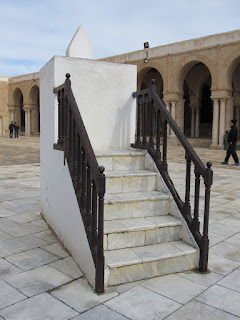The Great Mosque is the oldest Muslim place of worship in Africa. It is located in Kairouan. Founded in 670, the Mosque displays influences of pre-Islamic, Roman, and Byzantine architecture, which makes the artwork amazing. The mosque has an imposing courtyard, minaret, and decorated prayer halls. It represents an exceptional example of Islamic art.


The women had to wear a head covering to show respect. Some of us looked better than others!
A sundial an
d a well in the courtyard

It is important to note that the builders took materials, like these columns, from older ruined buildings like those we saw in Sbeitla. Why create new ones when these were available? Recycling at its best!

These blocks from Sbeitla were also placed into the Great Mosque. The left one is upside down. More recycling.
The Mosque is accessible only to Muslims, however non-Muslims can take a sneak peek into the prayer room and other public areas to admire its architectural beauty and appreciate its historical significance. The coverings at the base of the columns allow people to lean against the column without having to touch the cold stone



Kairouan is one of the oldest and most significant cities in Islamic history. Founded by the Arab general Uqba ibn Nafi, it was conceived as a strategic fortress and quickly developed into an important religious and cultural center. The name “Kairouan” derives from the Arabic meaning of “gathering place” or “camp.”
During the Middle Ages, the city became the center of trade and knowledge in North Africa. It was also the capital of Ifriqiya (the ancient name given the Tunisian region), and it exerted strong spiritual and political influence in its time. The city is known for hosting great scholars and for the construction of its mosque, which has attracted visitors and pilgrims for centuries.
Today, Kairouan keeps its history alive through its monuments, ancient neighborhoods, and religious traditions. The city is recognized as one of the four holy cities of Islam and represents an essential landmark for all travelers in Tunisia.
Abou Zamaa al-Balawi Mausoleum

The Abou Zamaa al-Balawi mausoleum, contains the remains of one of the Prophet's companions who was killed in battle with the Byzantine armies in 654 CE. This zawiya (oratory) was erected in his memory. It is reported that Abou Zamaa was carrying a few of the Prophet's hairs, which were buried with him.
The artwork was equally amazing with every inch of space decorated, and all of it handmade. Such imagination!
We had lunch at Kids Land, which looked like an elaborate MacDonald's Playland. The menu included Tunisian food as well as what have now become universal foods: tacos, burgers, pizza, and pasta. I had the burger with its own special sauce.
Medina

We spent the morning in the medina. We stopped at one of the Tunisian doughnut shops to taste one of these big pieces of fried dough. Like coffee shops, doughnut shops are a good small business venture.
The olives from those hundreds of thousands of olive trees need to be pressed to make olive oil, an essential staple of Tunisian cooking. We saw an old-fashioned oil press that was operated by a camel who didn't seem to mind going around in circles. Here's a video of the process.
Home Alone in the Kasbah
The Hotel Kasbah is a reconstructed fort in Kairouan. Kasbah means fort in Arabic.
Tonight we had the home-hosted dinner where people invite us into their homes for a visit and a meal. It is one of OAT's prime experiences because it gives travelers a chance to interact with local people. Very few tours give their clients this opportunity. Unfortunately, I had to cancel because my cold and cough had turned into a bout of diarrhea. I stayed at the hotel and used this time as an opportunity to write about being sick on a tour, which is not easy or fun.



When you don't feel good and are on the road you are not a good traveler. You don't want to socialize. You're not curious or adventurous. You don't take photos or notes. You're uninterested in what you're seeing. All you want is relief.
My throat was dry and scratchy three days ago due to the heater above my bed and the arid desert air. I dragged myself around antiquity in Sbeitla and eventually made it to the hotel where I went to bed early and slept. However, my illness morphed into diarrhea unexpectedly. That is especially problematic as I didn't dare be far from a bathroom, so touring was the last thing I wanted to do. Fortunately, this afternoon we returned to the hotel about 2 p.m., so I rested so I could participate in the evening's activity with the Tunisian family's home-hosted dinner.
I got myself ready and went downstairs to the meeting point in the hotel lobby and soon could see that I was going to be miserable. So I told one of my travel mates and emailed Anas, our guide, that I wasn't going. Without any food, and really not wanting it, I stayed in my room and drank tea, a soothing medicinal. I read a magazine, did crossword puzzles, and looked at the Internet. It wasn't a good news day with Trump creating chaos with his executive orders that could freeze all federal payouts. It's probably going to be like this for the next four years, but being sick right now is my more urgent concern. I'm hoping to be better tomorrow--and for the next three days of touring including the flight home. I looked forward to some good rest tonight! At least I had a beautiful room in the kasbah.
Resources
Kairouan -- https://www.tunisi.info/en/kairouan-what-to-see-and-where-to-stay/
mausoleum -- https://www.patrimoinedetunisie.com.tn/en/monuments/the-mausoleum-of-abu-zamaa-al-balawi/overview/



















No comments:
Post a Comment